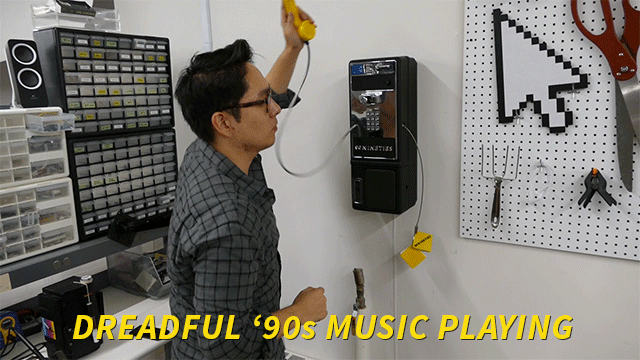Due largely to the overwhelming dominance of mobile phones, payphones are a sometimes overlooked relic from the 90’s and earlier eras. While seldom seen out in the wild these days, they can however still be acquired for a moderate fee — how many of you knew that? Setting out to prove the lasting usefulness of the payphone, Instructables user [Fuzzy-Wobble] has dialed the retro spirit way past eleven to his ’90 from the ’90s’ payphone boombox.
Conspicuously mounted in the corner of his office, a rangefinder sets the phone to ringing when somebody walks by — a fantastic trap for luring the curious into a nostalgia trip. Anyone who picks up will be prompted to punch in a code from the attached mini-phone book and those who do will be treated to one of ninety hits from — well — the 1990’s. All of the songs have been specifically downgraded to 128kbps for that authentic 90’s sound — complete with audio artifacts. There’s even a little easter egg wherein hitting the coin-return lever triggers the payphone to shout “Get a job!”
[Fuzzy-Wobble] notes that a payphone bracket is indispensable as most all payphones are made of cast iron, and nobody likes holes ripped out of their walls due to improper mounting. They’ve also provided their code as well as links to other tutorials for aspects of the build — such as the Adafruit music maker — throughout. Now you’ll have to excuse us as we groove while lost in a reverie.
Kick it back an extra decade and you get an 80’s boombox bluetooth speaker.
[Thanks for the submission, Alex S!!]















always gonna dial you up,
always gonna wait on hold,
never gonna call-collect, or charge you!
2600
This is as much a boom box as a hoverboard is a hoverboard…… Let us not lower our standards!
Probably conflated boombox and jukebox, since it fits the latter definition better.
Dreadful ’90s music? Oh no, my feels!
Saw the GIF and was expecting a lecture on electrical safety, but found out he was danceing and his moves are just as shoking.
So.. that inspired me to go browse Ebay looking for payphones. Why are they still so expensive? There are ones listed for parts as low as $50 but those are just gutted shells. They aren’t even good for projects like this unless you want to fabricate your own handset. For a complete working one it’s typically $200+!
Yah, I get it. These things were made to sit outside and take a ton of abuse. Construction like that came at a price. Still though… there are tons sitting on shelves, in closets, warehouses or wherever people are selling these from. Ebay is full of listings. But… hardly anyone actually uses them. It seems like a perfect recipee for cheap to me.. tons available but very little demand. I would think they would go for about the scrap value of their heavy steel frames.
Oh well…
I do miss the days when people carried pagers instead of cellphones and returned the calls via payphones. It was great! You could be reached any time, and almost anywhere just like today. But.. if you didn’t feel like talking you could just ignore it! ‘There was no payphone nearby’ was a very easy lie even if it was rarely true. It was the best of both worlds, the peace and privacy of the pre-cellphone days but most of the connectivity of current times. Then everyone got cellphones and always expect you to answer regardless of what you might actually be doing at the moment.
I was still doing that a few years into the millennium, when I was out and about, was 30c a minute on the cell, and payphones were still common enough and 25 cents, so if I had a quarter I’d call back on a payphone… but then it got so they were few and far between and 50 cents here, so stopped doing it, unless one was right in sight and I knew I was going to be a few minutes.
I was a former payphone technician with a payphone route from San Francisco, West of Van Nuys Blvd, down to San Mateo. The company I worked for had as many as 50K+ payphones before the downward spiral of revenues due to the mobile phone industry. It was good while it lasted.
The payphones had circuit boards, low speed modems, mechanical coin relay and an escrow bucket, among other interesting things. Routing a payphone through a VoIP was also possible but there were some occasional toll free dialing registration errors.
I used to design dials (hearing impaired), “smart electronics” and fraud-protection devices for payphones from 1985 to 1998. The 3 major ones were GTE, Northern Telecom and Western Electric. I used to have one hanging on the wall in my garage. It worked as a standard telephone so I could take calls on it if I wanted to.